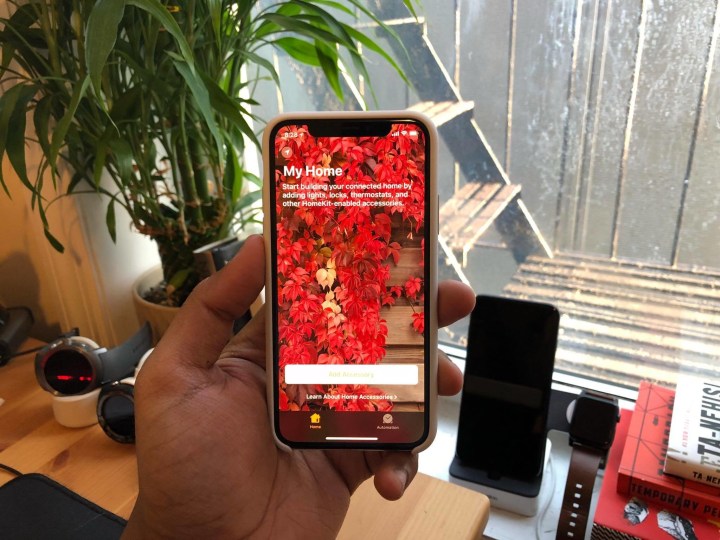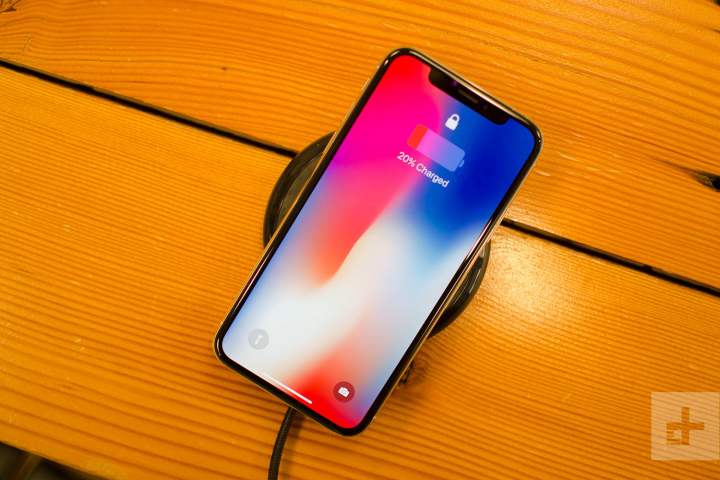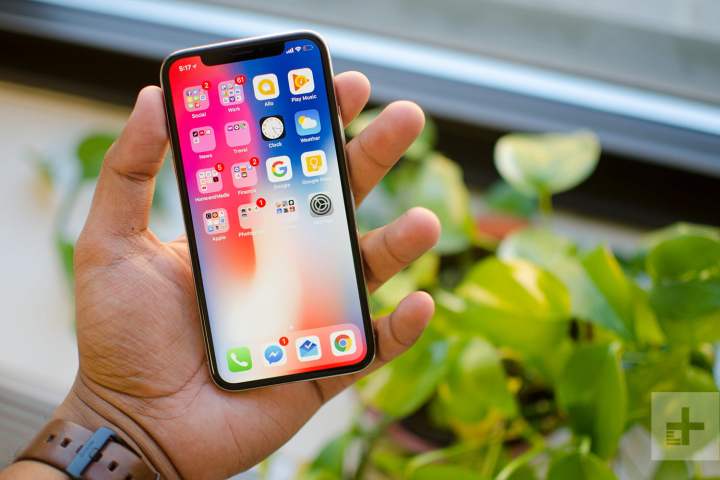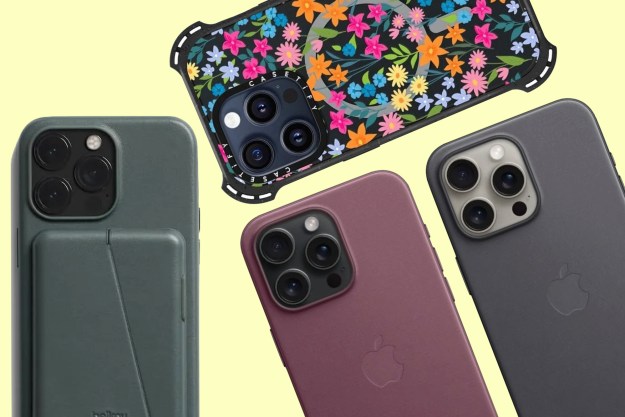
Specs
Razer Phone |
iPhone X |
|
| Size | 158.5 x 77.7 x 8 mm (6.24 x 3.06 x 0.31 inches) | 143.6 x 70.9 x 7.7 mm (5.65 x 2.79 x 0.30 inches) |
| Weight | 197 grams (6.95 ounces) | 174 grams (6.14 ounces) |
| Screen | 5.7-inch 120 Hz Ultramotion IGZO IPS LCD display | 5.8-inch Super Retina OLED display |
| Resolution | 2560 x 1440 pixels (514 ppi) | 2436 x 1125 pixels (458 ppi) |
| OS | Android 7.1.1 Nougat | iOS 11 |
| Storage | 64GB | 64GB, 256GB |
| MicroSD card slot | Yes | No |
| NFC support | Yes | Yes (Apple Pay only) |
| Processor | Snapdragon 835 with Adreno 540 | A11 Bionic with 64-bit architecture, M11 motion co-processor |
| RAM | 8GB | 3GB |
| Connectivity | GSM, UMTS, HSPA, TD-SCDMA, LTE, TDD LTE, 802.11 a/b/g/n/ac Wi-Fi | 4G LTE, GSM, CDMA, HSPA+, 802.11a/b/g/n/ac Wi-Fi |
| Camera | Dual 12 MP rear (f/1.75 wide angle & f/2.6 zoom), 8 MP front | Dual 12 MP rear, 7 MP FaceTime HD front |
| Video | Up to 4K at 30 fps | Up to 4K at 60fps, 1080p at 240fps |
| Bluetooth | Yes, version 4.2 | Yes, version 5.0 |
| Audio | Dual front-facing speakers, no headphone jack | Stereo speakers, no headphone jack |
| Fingerprint sensor | Yes | No, has Face ID instead |
| Other sensors | Accelerometer, gyro, proximity, compass | Accelerometer, gyro, proximity, compass, barometer |
| Water resistant | No | Yes, IP67 rated |
| Battery | 4,000mAh
Qualcomm QuickCharge 4.0+ |
2,716mAh
21 hours of talk time, 13 hours of internet, 14 hours of video playback, and up to 60 hours of audio playback Fast-charging — 50 percent charge in 30 minutes, wireless charging (Qi standard) |
| Charging port | USB-C | Lightning |
| Marketplace | Google Play Store | Apple App Store |
| Colors | Black | Space Gray, Silver |
| Availability | Razer | AT&T, Verizon, T-Mobile, Apple |
| Price | $700 | $999 |
| DT review | Hands-on review | 4.5 stars out of 5 |
The Razer Phone is packed to the gills with top-of-the-line Android flagship specs. The Snapdragon 835 has been tried-and-tested in the Galaxy Note 8, the LG V30, and the Pixel 2, and it’s a powerful chip with a lot to offer. Bundled with the Razer Phone’s 8GB of RAM, you’ve got a device that packs a lot of power and should be able to handle everything you throw at it. So it’s extra impressive when the iPhone X’s A11 Bionic chip blows the Snapdragon 835 out of the water. Benchmarks aren’t everything, but they are a decent way of gauging performance, and the A11 chip in the iPhone X has repeatedly beaten the Snapdragon 835 in tests. While the iPhone X only has 3GB of RAM under the hood, iOS and Android devices handle RAM very differently, so the Razer Phone’s extra 5GB of RAM doesn’t necessarily promise better performance.
Neither device has a headphone jack, so it’s good to see that the iPhone X comes with the additional signal strength and features granted by Bluetooth 5.0 — the Razer Phone is stuck with Bluetooth 4.2, despite the ditching of the 3.5mm port. Why remains a mystery, but it’s a shame to see.
The winner is less clear when it comes to available storage space. While the Razer Phone is definitely the loser in terms of internal storage options, only having a 64GB model to pit against the 64GB and 256GB options on the iPhone X, the Razer Phone does have a MicroSD slot to bolster that available space by up to 256GB.
The winner here is pretty clear. There’s no doubt that the Snapdragon 835-powered Razer Phone is powerful — but the A11 Bionic processor is just too well optimized with iPhone hardware. The iPhone X takes it.
Winner: iPhone X
Design and display
The iPhone X is Apple’s first phone to follow the trend for minimal bezels, and the design has been carefully tuned to match the futuristic aesthetic that other manufacturers have set. A 5.8-inch OLED display dominates the front of the phone (minus the divisive notch), and while it isn’t a true edge-to-edge display, you’d be hard-pressed to notice thanks to how smooth and razor-sharp the display is.
The rest of the phone is clad in a mixture of steel sides and a glass back that allows for wireless charging. It’s a gorgeous design, and if you manage to tear your eyes away from the display, you’re sure to get them stuck all over again on the design of the phone itself. The rear camera is stacked vertically, so you can tell you’re looking at an iPhone X, even from the back.
The Razer Phone couldn’t be more different. Razer eschewed the bezel-less trend, opting for a phone that’s more reminiscent of a last-generation smartphone. One look is enough to tell you why — Razer has equipped this phone with two powerful front-facing speakers that flank the screen. It’s like an Xperia XZ Premium had a child with an old plasma TV, and it’s a look we dig. Following recent trends is all very well and good, but it’s nice to see something more classic once in a while. The whole phone is clad in aluminum, so there’s no wireless charging here.
The Razer Phone’s display is a 5.7-inch IPS LCD which uses 120Hz Ultramotion technology. What does that mean? It means that the display runs at twice the usual speed of a smartphone display. This isn’t new tech by any means — we’ve previously seen it on the iPad Pro — but it’s still seriously impressive, and it makes the phone’s performance seem even smoother.
In terms of durability, it’s a mixed bag. The Razer Phone will likely be able to take more of a pounding than the iPhone X, thanks to the durability advantage of aluminum over glass and steel (plus, an iPhone repair bill is hefty, so we recommend a case for the iPhone). But, the iPhone X comes with an IP67 rating, while the Razer Phone isn’t rated for any water or dust-resistance at all. Another miss for a 2017 flagship.
We’ve got to hand it to the iPhone X here. We like Razer’s throwback to older smartphone design, and the addition of dual speakers and the 120Hz display. But a speedy display can’t match the gorgeous colors and sharpness of the OLED display on the iPhone, and the X’s design is one of the most stunning we’ve seen in years — as well as a welcome change for Apple fans. You might worry about smashing the glass, but the iPhone X is seriously gorgeous.
Winner: iPhone X
Camera
We’ll keep this one brief, since it’s not much of a contest. On paper, the Razer Phone is packing a decent enough camera package, with two 12-megapixel lenses — one zoom lens and one wide-angle lens. However, it’s clear that Razer’s focus isn’t on the camera — the software is barebones, and lacking in the features you’d expect from a 2017 flagship phone.
In contrast, the iPhone X is a contender for one of the best camera phones of the year. It has similar shooters to the iPhone 8 Plus (and that got a spot on our best smartphone cameras round-up), with small additions made to make the lenses that much better. We won’t go into too much detail here, but the iPhone X produces gorgeous photos, with a great simulated bokeh effect. You can also throw Face ID into the mix here, with Apple’s peerless technology able to detect your face in almost any circumstance and unlock your phone. It’s an incredible innovation on what we’ve seen other manufacturers do in the past, and even if we have our doubts about it replacing Touch ID, it’s still great tech.
The iPhone X wins this by a country mile.
Winner: iPhone X
Battery life and charging

This is where it starts to get a little harder for Apple’s best. As with the design, these phones have taken a very different approach to battery size and optimization. The iPhone X comes with a 2,716mAh battery that should provide a day’s use, even with medium to heavy usage. Fast charging is possible on the iPhone X, but not with the cable included in the box — and you have to wonder why. If you put the $25 down for the fast charging cable, you should see some pretty nifty charging speeds — we saw it go from 25 percent to full in an hour and 40 minutes in our iPhone X review. Wireless charging is also available, using the Qi standard, so if you’re a fan of not plugging cables into your phone that’s a thing you can do.
In contrast, the Razer Phone packs in a whopping 4,000mAh battery, clearly preferring brute strength to the optimization of the iPhone X’s battery. We suspect that the 120Hz screen might be a heavy draw on the battery, but we’ll have to leave that as speculation until we get a chance to fully review the Razer Phone. Still, that massive battery should be able to see you through the day — you should really question why, if it fails to — and while there’s no wireless charging because of the aluminum body, the Razer Phone comes loaded with the new QuickCharge 4.0+, which Razer claims will charge the battery from zero to 50 percent in 35 minutes. That’s an impressive boast if it’s true, especially with a battery that size.
We can’t rule this one until we get a chance to fully test the Razer Phone. The iPhone X gets points for the wireless charging, but loses some for not including fast charging in the box. For now, this is a tie.
Winner: Tie
Software
Comparing Android and iOS is like comparing apples and oranges. You can like both, and you can have a favorite over the other, but ultimately they’re two very different experiences, and whichever one you choose will be down to your personal preferences.
On the iPhone X, iOS 11 is a beautiful piece of software. It’s fast and fluid, and runs smoothly both in apps and when swapping between them. The iconic home button has been removed to make room for that gorgeous screen, and the functionality it offered has been replaced by gestures. Swiping around to get back to the homepage, access the notification section, and see your recent apps is generally easy to get used to, though some of the gestures were easily confused by iOS 11 itself, and caused a few minor niggles. You can find our full breakdown of how iOS 11 performs in our review.
If iOS 11 on the iPhone X is a well managed walled garden, then Android on the Razer Phone is a “choose-your-own-adventure” LARP game set in an open forest. Thanks to the implementation of Nova Launcher Prime on the Razer Phone, the user has complete control over almost every part of their phone’s interface. Interested in iOS 11’s gestures? Nova Launcher Prime has a way for you to try that out on your Razer Phone. It also has options for loads more control, including how many icons can fit in your app drawer or home page. Customization via Nova Launcher Prime aside, the Razer Phone runs stock Android 7.1 Nougat, so there’s no additional bloatware slowing the phone down, meaning that Android on the Razer Phone is fluid and smooth. Razer has also said that the Razer Phone will be getting an update to Android 8.0 Oreo in early 2018.
Both phones have access to their own voice assistants — Siri on the iPhone X, and Google Assistant on the Razer Phone. The Razer Phone has a slight edge with the ability to run some virtual reality (VR) apps, via Android’s own support. Apple has yet to implement any VR in its phones, though they do have the edge in augmented reality (AR). However, both are fairly small points in this battle.
As ever, your choice between the two operating systems is a highly personal one. Whichever you choose, you’ll find that both phones are smooth performers with a lot to offer. This has to be a tie.
Winner: Tie
Price and availability

You can currently pre-order the Razer Phone for $700 from the Razer Store. Shortly after it launches on November 17 it will also be available in selected Microsoft Stores, and on Amazon. It will come unlocked for use on your choice of network, but Sprint and Verizon customers should be aware that the phone will not work on their networks.
The iPhone X is currently available from all major carriers, and starts at a whopping $1,000 for the 64GB model. Upgrading to the 256GB model will cost another $150, but you can see all of your buying options in our iPhone X buying guide.
The iPhone X may be available on more networks, but the $1,000+ price tag is proving a difficult pill to swallow. The cheaper price of the Razor phone wins this round.
Winner: Razer Phone
Overall winner: iPhone X

This shouldn’t come as a surprise for anyone. Apple’s latest phone is a stunner in both looks and implementation. It has one of the smoothest mobile operating systems on the planet, and probably the most powerful chipset inside. The camera is capable of taking some incredible pictures, and everything else has that mark of Apple quality. Sure, Face ID may not be as fast as Touch ID, and you may still lament the loss of the headphone jack, but the iPhone X represents the next big thing for Apple, and it’s the new design that the fans deserved.
But that doesn’t mean the Razer Phone is a bad choice. Razer is marketing this phone towards gamers and people who use their phone primarily to consume media. In that sense, the Razer Phone is a winner. The dual speakers are incredibly loud and clear, and the 120Hz Ultramotion display is gorgeous. But overall, it can’t beat Apple’s iPhone X.
Editors' Recommendations
- An Apple insider just revealed how iOS 18’s AI features will work
- iPhone 16: news, rumored price, release date, and more
- 10 iPhone productivity apps you need to download right now
- Best phone deals: Save on the iPhone, Galaxy Z Fold 5, and more
- The 10 best photo editing apps for Android and iOS in 2024





